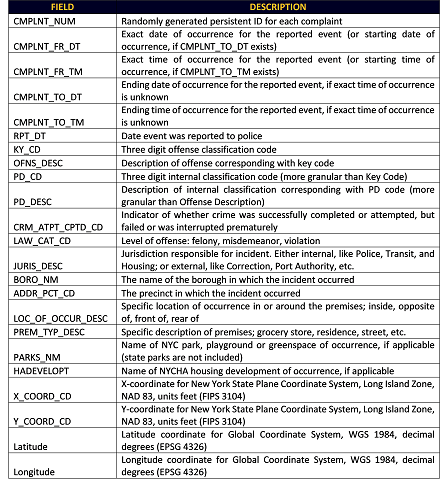Group11 Proposal
|
|
|
|
|
|
Contents
Introduction
Crime is an act punishable by law that has been timeless and has been committed practically since the start of time. Crime is prevalent in every society. Crime activities are monitored and recorded by law enforcement agencies for various purposes. One such purpose is crime analysis. Crime analysis involves systematic analysis for identifying and analyzing patterns and trends in crime and disorder.
For our crime analysis, we will be using the New York Police Department (NYPD) crime data for the City of New York. The City of New York, or more popularly known as NYC or just New York, is the most populous city in the United States. As of 2017, the population of NYC stands at 8.62 million people. Situated on the Hudson river, NYC consists of 5 boroughs:
1. Brooklyn: Brooklyn is the most populous borough of NYC. It borders the borough of Queens and has several bridge connectors to the boroughs of Staten Island and Manhattan.
2. Queens: Queens is the easternmost and largest in area of the five boroughs of New York City. It is geographically adjacent to the borough of Brooklyn the southwestern end of Long Island. Queens has the most diversified economy of the five boroughs of New York City. It is home to JFK International Airport and LaGuardia Airport.
3. Manhattan: Manhattan is the most densely populated borough of New York City, its economic and administrative centre, and its historical birthplace. Manhattan is often described as the cultural, financial, media, and entertainment capital of the world, and is home to the United Nations Headquarters and Wall Street.
4. The Bronx: The Bronx is the northernmost of the five boroughs of New York City. The Bronx contains one of the five poorest Congressional Districts in the United States, the 15th, but its wide diversity also includes affluent, upper-income and middle-income neighbourhoods.
5. Staten Island: Staten Island is the southernmost and westernmost of the five boroughs of New York City in the U.S. state of New York. Staten Island is the least populated of the boroughs but is the third-largest in land area.
Quick stats of New York City:
Through our analysis, we hope to provide a comprehensive overview of crime statistics in these 5 boroughs of New York City and illustrate the power of using this data for predictive policing for law enforcement agencies across the world.
Motivation
Crime analysis is required to reveal the complexities of crime records. This process will help the law enforcement in identifying potential hotspots and implementing crime prevention strategies. The ability to predict the future crimes based on the location, pattern and time can serve as a valuable source of knowledge for them either from strategic or tactical perspectives. To predict future crime accurately with a better performance, it is a challenging task because of the increasing numbers of crime in present days, and erratic activity patterns. Therefore, crime prediction method is important to identify the future crime and reduces the numbers of crime.
Key Objectives
Through our analysis, we hope to address the following:
1. Provide a visual representation of crime statistics: Through our visual dashboard, we can provide a one stop view for the exploratory analysis of crime stats. The user will be able to view, compare and analyse crime stats based on type of crime, location, time of day, duration of crimes, Complete/incomplete crimes, and crimes occurring in parks and subway stations.
2. Develop a Predictive Policing Visual Tool: With an extensive NYPD crime data at our disposal, we can utilize it for creating a predictive model. For our predictive model, we will be adopting an Epidemic-Type Aftershock Sequence Model for Crime Prediction. The ETAS model will utilize past crime data such as location, time of day and type of crime to predict hotspot locations for future crimes based on probability values. We aim to visualize our findings to help assist law enforcement agencies for strategic or tactical action.
Project Timeline
Project Deliverable
Data set and Description
1. NYPD Complaint Data
This is the main dataset in use. It consists of records of crime incidents at the time of system record to the NYPD from 2006 to 2016. The crime incidents range from robberies to larceny.

2. Precinct Data.
The city of New York consists of 77 precincts across the five boroughs. This dataset covers the locations of the police precincts.

3. New York Subway Stations
New York city consists of the rapid transit system with 472 stations across the five boroughs.
This dataset covers the locations of the stations to help in geo-locating crime scenes.

4. Parks in New York
There are multiple Parks in New York that are municipal and privately-owned parks including Central Park which serve as a scene for a large proportion of the crimes recorded. This dataset covers the locations of the parks.

5. New York Sector Data
This serves as an additional dataset to identify the patrol areas and boundaries of the individual precincts across the five boroughs.

Visualization Tools and Packages
Visualization using R:
